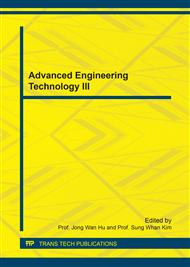[1]
G. M. An, Q. Y. Yang, L. J. Yang, et al. Comparison between static and dynamic elastic moduli of rock mass in a nuclear power plant, Rock Soil Mechan. 32(s1) (2011) 565-569.
Google Scholar
[2]
M. Q. You, C. D. Su, Effect of length of fine and coarse crystal marble specimens on uniaxial compression tests, Chin. J. Rock Mech. Eng. 23(22) (2004) 3754-3760.
Google Scholar
[3]
S. J. Yang, H. Zeng, H. L. Wang, Experimental analysis on mechanical effescts of loading rates on limestone, Chin. J. Geotech. Eng. 27(7) (2005) 786-788.
Google Scholar
[4]
K. Yang, L. Yuan, L. G. Qi, et al. Establishing predictive model for rock uniaxial compressive strength of No. 11-2 coal seam roof in Huainan mining area, Chin. J. Rock Soil Mech. Eng. 32(10) (2013) 1991-(1998).
Google Scholar
[5]
Per Horsrud, Estimating mechanical properties of shale from empirical correlations, SPE Drill. Complet. 16(02) (2001) 68-73.
DOI: 10.2118/56017-pa
Google Scholar
[6]
C. D. Chang, M. D. Zoback, A. Khaksar, Empirical relations between rock strength and physical properties in sedimentary rocks, J. Petrol. Sci. Eng. 51(3-4) (2006) 223-237.
DOI: 10.1016/j.petrol.2006.01.003
Google Scholar
[7]
Z. R. Meng, J. C. Zhang, T. Joachim, Relationship between physical and mechanical parameters and acoustic wave velocity of coal measures rocks, Chin. J. Geophys. 49(5) (2006) 1505-1510.
DOI: 10.1002/cjg2.959
Google Scholar
[8]
J. Jiang, J. Z. Sun, Y. H. Qiao, X. S. Yang, Comparison between static and dynamic parameters of grand buddha rockmass specimens in west JinYang mountain in TaiYuan, Chin. J. Rock Mech. Eng. 26(s1) (2007) 3452-3460.
Google Scholar
[9]
S. M. LIU, L. H. Xu, Y. Q. Li, Experimental study on rock physical and mechanical properties in Danjiangkou reservoir area, J. Huazhong Univ. Sci. Technol. (Urban Science Edition), 24(4) (2007) 54-58.
Google Scholar
[10]
J. F. Jin, X. B. Li, Z. Q. Yin, Realationship between physical parameters and acoustic wave velocity of dacite porphyry, Min. R&D, 31(2) (2011) 15-17.
Google Scholar
[11]
Evert Hoek, Edwin T Brown. Underground excavations in rock, (1980).
Google Scholar
[12]
P. B. Robert, F. Amann, P. K. Kaiser, et al. Interpretation of UCS test results for engineering design, 13th ISRM International Congress of Rock Mechanics, (2015).
Google Scholar
[13]
Isrm Suggested Methods. Rock characterization testing and monitoring. Pergamon Press, Oxford; 1981. pp.113-116.
Google Scholar
[14]
Astm. Standard Test Method for Elastic Moduli of Intact Rock Core Specimens in Uniaxial Compression. ASTM Stand0408(D3148)(1993).
DOI: 10.1520/d3148-96
Google Scholar
[15]
W. R. Dearman, F. J. Baynes, T. Y. Irfan, Engineering grading of weathered granite, Eng. Geol. 12 (1978) 345-374.
DOI: 10.1016/0013-7952(78)90018-2
Google Scholar
[16]
A. Tuǧrul, The effect of weathering on pore geometry and compressive strength of selected rock types from Turkey, Eng. Geol. 75(3) (2004) 215-227.
DOI: 10.1016/j.enggeo.2004.05.008
Google Scholar
[17]
L. Vernik, M. Bruno, C. Bovberg, Empirical relations between compressive strength and porosity of siliciclastic rocks, Int. J. Rock Mech. Min. Sci. Geomech. Abstr. 30(7) (1993) 677-680.
DOI: 10.1016/0148-9062(93)90004-w
Google Scholar
[18]
H. J. David, M. N. Toksöz, Ultrasonic P and S wave attenuation in dry and saturated rocks under pressure, J. Geophys. Res.: Solid Earth, 85(B2) (1980) 925-936.
DOI: 10.1029/jb085ib02p00925
Google Scholar
[19]
E. I. Mashinskii, Variants of the strain-amplitude dependence of elastic wave velocities in rocks under pressure, J. Geophys. Eng. 1(4) (2004) 295.
DOI: 10.1088/1742-2132/1/4/008
Google Scholar


